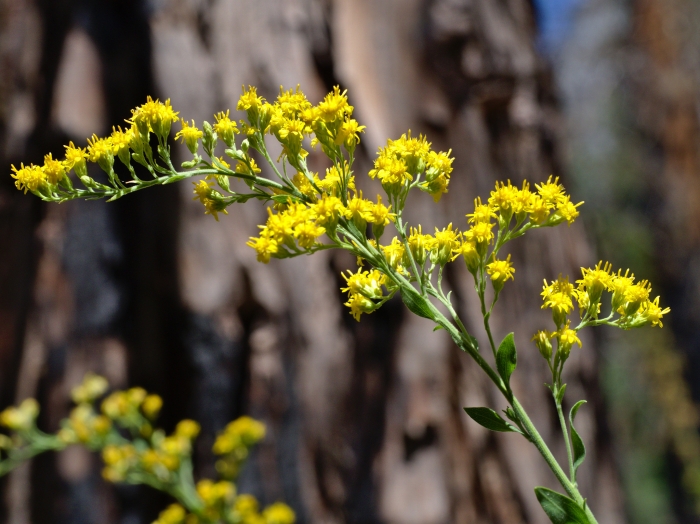California Goldenrod
(Solidago californica)
California Goldenrod (Solidago californica)
/
/

Edward Ricemeyer
CC BY-SA 2.0
Image By:
Edward Ricemeyer
Recorded By:
Copyright:
CC BY-SA 2.0
Copyright Notice:
Photo by: Edward Ricemeyer | License Type: CC BY-SA 2.0 | License URL: https://creativecommons.org/licenses/by/2.0/ | Uploader: esrice | Publisher: Flickr |



































Estimated Native Range
Summary
Solidago californica, commonly known as California Goldenrod, is a deciduous perennial herb native to open woodlands, grasslands, and coastal scrub areas in California, with its range extending to Oregon and Baja California. It can reach up to 1.5 meters (5 ft) in height and is characterized by its hairy stem and lance-shaped leaves, which are larger at the base, up to 14 cm (5+1⁄2 in) long, and become progressively smaller higher up the stem. The plant’s inflorescences are showy, narrow, and often one-sided clusters of many small flower heads, each with numerous yellow disc florets and up to 11 narrow yellow ray florets that are about 5 mm (1⁄4 in) long. The blooming period is typically in the late summer to fall, adding vibrant color to the landscape during this time.
California Goldenrod is valued for its drought tolerance and ability to attract pollinators such as bees and butterflies, making it a beneficial addition to native plant gardens, pollinator gardens, and restoration projects. It thrives in full sun to part shade and prefers soils with medium to fast drainage, requiring low amounts of water once established. While it is not commonly used in culinary or medicinal applications, its ornamental value and ecological benefits make it a popular choice for low-water landscapes. Gardeners should be aware that it can spread via rhizomes, potentially becoming aggressive in garden settings.CC BY-SA 4.0
California Goldenrod is valued for its drought tolerance and ability to attract pollinators such as bees and butterflies, making it a beneficial addition to native plant gardens, pollinator gardens, and restoration projects. It thrives in full sun to part shade and prefers soils with medium to fast drainage, requiring low amounts of water once established. While it is not commonly used in culinary or medicinal applications, its ornamental value and ecological benefits make it a popular choice for low-water landscapes. Gardeners should be aware that it can spread via rhizomes, potentially becoming aggressive in garden settings.CC BY-SA 4.0
Plant Description
- Plant Type: Herb
- Height: 2-3 feet
- Width: 1-2 feet
- Growth Rate: Rapid
- Flower Color: Yellow
- Flowering Season: Summer, Fall
- Leaf Retention: Deciduous
Growth Requirements
- Sun: Full Sun, Part Shade
- Water: Low
- Drainage: Fast, Medium
Common Uses
Bee Garden, Bird Garden, Border Plant, Butterfly Garden, Deer Resistant, Drought Tolerant, Fragrant, Groundcover, Hummingbird Garden, Low Maintenance, Potted Plant, Rabbit Resistant, Showy Flowers, Street Planting
Natural Habitat
Native to open woodlands, grasslands, and coastal scrub areas in California, Oregon, and Baja California
Other Names
Common Names:
Scientific Names: Solidago californica , Solidago velutina subsp. californica , Solidago californica var. aperta , Solidago californica var. californica
GBIF Accepted Name: Solidago californica Nutt.